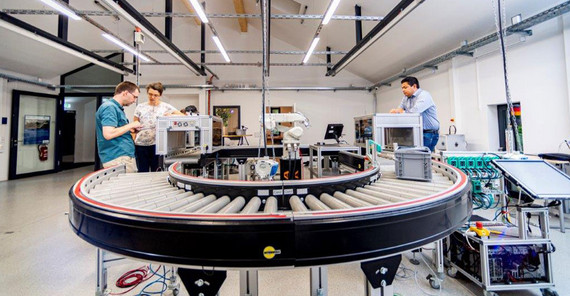These questions are part of my daily work at the Potsdam Center for Industry 4.0 (ZIP4.0), which is located on the premises of the “Digitalvilla” on Karl Marx Strasse in Potsdam-Babelsberg. With the hybrid model factory, a simulator for manufacturing processes, we are investigating the integration of new systems and how to operate them most efficiently, how these systems can interact with established technologies expediently, and which stumbling blocks come up on the path to modern production systems. For this purpose, there is a toolkit in the model factory with the help of which we can simulate and test production scenarios. There are different machine simulators, intelligent workpiece carriers that steer themselves through production, industrial robots and roller conveyors, mobile devices, and many more. All this, the actors can operate, maintain, and test, e.g. in the role of a machine operator within a production scenario.
At the moment, we are working on integrating another module for the factory of the future: smart glasses. A typical example of how novel things find their way onto the shop floor. These glasses are meant as a tool enabling the actors in the plant to master complex tasks. At the same time, the new module will expand the toolkit for research activities. Colleagues can then use them, for example, in their experiments to design assistance systems or to conduct usability studies.
After gathering possible application scenarios, we decide on the type of support for the machine operator in the maintenance process. Then it is time to design the storyboard and select the devices. One possible candidate is Microsoft’s HoloLens. Is this device really a suitable solution? Is it functional and safe, even under the rough conditions at a factory? After an initial round of testing with partners from the industry, we choose another device, the HMT-1. As so-called assisted reality glasses, they fit the requirements best. After the storyboard, the next step is implementing the corresponding functions in the simulator and on the glasses themselves. After all, the device needs data from the process and at the same time returns information from its application to the simulation system. For this purpose, the system must be configured and additionally programmed with the help of web services. Only a short time later, the system and the glasses are ready for use…
However, the model factory is constantly changing, growing, and being rebuilt. It has become apparent, for example, that the central control principle of our roller conveyor system has reached its limits. Using just one control computer to regulate all activities creates an extremely high level of complexity and does not seem sustainable due to an increasing need for adaptability. It was imperative to find a remedy here. Researchers were therefore called upon to find a suitable concept and engineers to develop a solution from this concept that would be useful in practice. Fortunately, ZIP4.0 offers both. Within a few weeks, the alternative control system for the transport system is “up and running” – with an interplay of cyber-physical systems, each responsible for a segment of the roller conveyor and drawing on a number of centrally provided services. It is a simple principle at first glance but has required a considerable amount of research and development to be implemented. The future of the factory has already taken shape in ZIP4.0.

